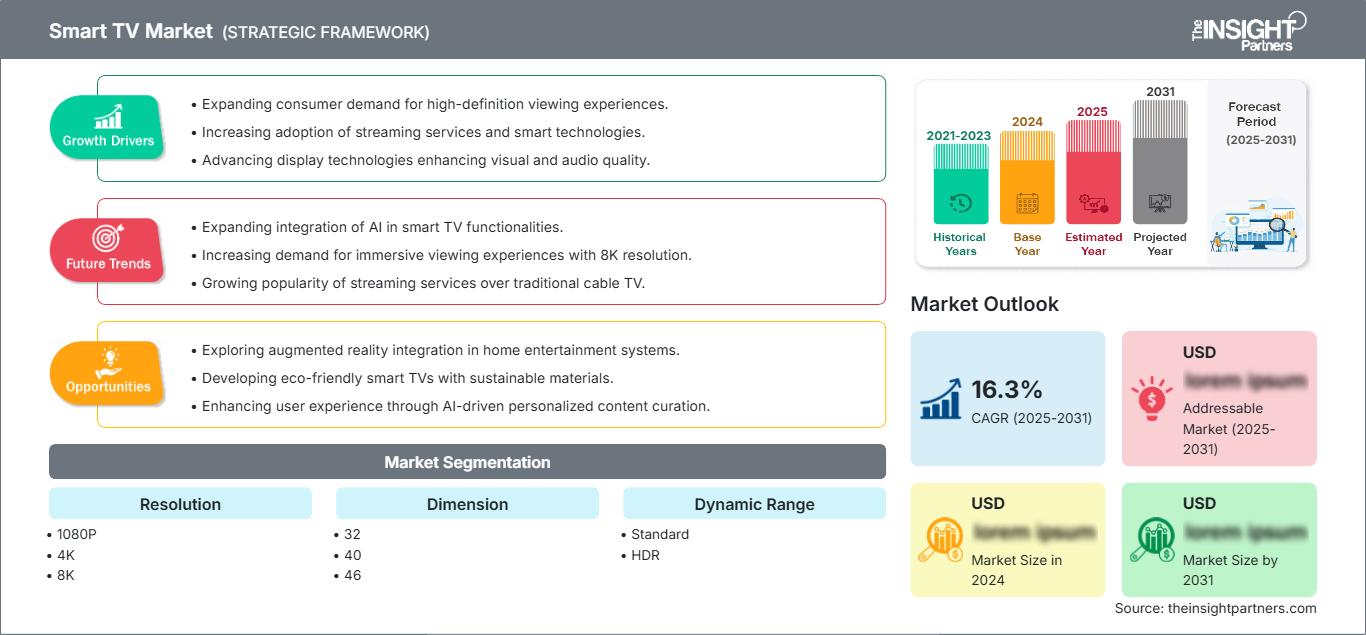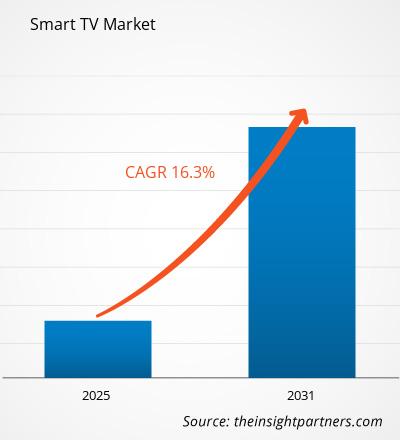Se espera que el mercado de televisores inteligentes registre una CAGR del 16,3 % entre 2025 y 2031, y que el tamaño del mercado se expanda de US$ XX millones en 2024 a US$ XX millones en 2031.
El informe está segmentado por resolución (1080P, 4K, 8K, otras), dimensión (32, 40, 46, 55, 75 y superior), rango dinámico (estándar, HDR) y aplicación (residencial, comercial). El análisis global se desglosa a nivel regional y por países principales. El informe ofrece el valor en USD para el análisis y los segmentos mencionados.
Propósito del Informe
El informe "Mercado de Smart TV" de The Insight Partners busca describir el panorama actual y el crecimiento futuro, los principales factores impulsores, los desafíos y las oportunidades. Esto proporcionará información a diversos actores del sector, como:
- Proveedores/fabricantes de tecnología: Para comprender la dinámica cambiante del mercado y conocer las oportunidades potenciales de crecimiento, lo que les permitirá tomar decisiones estratégicas informadas.
- Inversores: Realizar un análisis exhaustivo de tendencias respecto a la tasa de crecimiento del mercado, las proyecciones financieras del mercado y las oportunidades que existen en toda la cadena de valor.
- Órganos reguladores: Regular las políticas y las actividades policiales en el mercado con el objetivo de minimizar el abuso, preservar la confianza de los inversores y defender la integridad y estabilidad del mercado.
Segmentación del mercado de televisores inteligentes
Resolución
- 1080P
- 4K
- 8K
- Otros
Dimensión
- 32
- 40
- 46
- 55
- 75 años o más
Rango dinámico
- Estándar
- HDR
Solicitud
- Residencial
- Comercial
Obtendrá personalización en cualquier informe, sin cargo, incluidas partes de este informe o análisis a nivel de país, paquete de datos de Excel, así como también grandes ofertas y descuentos para empresas emergentes y universidades.
Mercado de televisores inteligentes: perspectivas estratégicas

- Obtenga las principales tendencias clave del mercado de este informe.Esta muestra GRATUITA incluirá análisis de datos, desde tendencias del mercado hasta estimaciones y pronósticos.
Factores que impulsan el crecimiento del mercado de televisores inteligentes
- Aumento de la demanda de contenido en streaming por parte de los consumidores: La creciente popularidad de servicios de streaming como Netflix, Hulu y Amazon Prime Video es un importante impulsor del mercado de los televisores inteligentes. Los consumidores buscan cada vez más dispositivos que ofrezcan acceso fluido a una variedad de contenido en línea, como películas, programas de televisión y deportes en directo. Los televisores inteligentes, equipados con aplicaciones integradas e interfaces intuitivas, satisfacen esta demanda ofreciendo funciones de streaming directo. A medida que más hogares abandonan las suscripciones de cable tradicionales, crece la demanda de televisores inteligentes que mejoran la experiencia de visualización, impulsando las ventas.
- Avances en la tecnología de visualización: Los continuos avances en la tecnología de visualización, como 4K, OLED y QLED, impulsan el mercado de los televisores inteligentes. Estas tecnologías mejoran la calidad de imagen, ofreciendo a los consumidores imágenes más nítidas, colores vibrantes y un contraste mejorado. A medida que los fabricantes innovan e introducen nuevas funciones, los consumidores se sienten cada vez más atraídos por los televisores inteligentes de alto rendimiento que ofrecen experiencias de visualización superiores. Además, la creciente disponibilidad de contenido de alta definición impulsa la adopción de tecnologías de visualización avanzadas, lo que impulsa aún más la demanda de televisores inteligentes en el mercado.
- Integración de ecosistemas de hogares inteligentes: La creciente tendencia de la domótica está influyendo significativamente en el mercado de los televisores inteligentes. Los consumidores buscan dispositivos que se integren a la perfección con sus sistemas de hogar inteligente, como asistentes de voz (p. ej., Amazon Alexa, Google Assistant) y productos de domótica. Los televisores inteligentes compatibles con diversos dispositivos domésticos inteligentes ofrecen mayor comodidad y mejoran la experiencia del usuario. A medida que el mercado evoluciona, la posibilidad de controlar las funciones del hogar inteligente a través de televisores inteligentes se está convirtiendo en una característica esencial, impulsando el interés de los consumidores y el crecimiento del mercado.
Tendencias futuras del mercado de televisores inteligentes
- Auge de la Inteligencia Artificial y la Personalización: La integración de la inteligencia artificial (IA) en los televisores inteligentes se está convirtiendo en una tendencia destacada, mejorando la experiencia del usuario mediante recomendaciones de contenido personalizadas e interfaces más inteligentes. Los algoritmos de IA analizan los hábitos y preferencias de consumo para sugerir programas, películas y aplicaciones relevantes, facilitando a los usuarios descubrir nuevo contenido. A medida que los televisores inteligentes se vuelven más intuitivos y responden a las preferencias individuales, se espera que esta tendencia moldee las expectativas de los consumidores e impulse nuevas innovaciones en el mercado de los televisores inteligentes.
- Transición hacia modelos de suscripción: Existe una tendencia creciente hacia modelos de suscripción para la distribución de contenido en televisores inteligentes. Muchos consumidores prefieren la flexibilidad de suscribirse a diversos servicios de streaming en lugar de comprometerse con los paquetes de cable tradicionales. Este cambio está dando lugar a la aparición de servicios de suscripción en paquete, donde los consumidores pueden acceder a múltiples plataformas a través de un solo paquete. A medida que esta tendencia cobra fuerza, es probable que los fabricantes de televisores inteligentes exploren alianzas con servicios de streaming para ofrecer paquetes exclusivos, mejorando la propuesta de valor general para los consumidores e impulsando las ventas de televisores inteligentes.
Oportunidades del mercado de televisores inteligentes
- Expansión de los videojuegos y los deportes electrónicos: El auge de la industria de los videojuegos representa una oportunidad lucrativa para el mercado de los televisores inteligentes. Con el auge de los videojuegos en línea y los deportes electrónicos, los consumidores buscan cada vez más televisores inteligentes que ofrezcan altas frecuencias de actualización, baja latencia y gráficos inmersivos. Los fabricantes pueden aprovechar esta tendencia diseñando televisores inteligentes específicamente optimizados para experiencias de juego, con modos de juego dedicados y compatibilidad con las consolas más populares. Al dirigirse al público de los videojuegos, las empresas pueden ampliar su alcance de mercado e impulsar las ventas en este segmento en crecimiento.
- Adopción en Mercados Emergentes: La expansión de los televisores inteligentes en los mercados emergentes representa una importante oportunidad de crecimiento. A medida que aumentan los ingresos disponibles y la penetración de internet en regiones como Asia-Pacífico, África y Latinoamérica, cada vez más consumidores buscan actualizar sus sistemas de entretenimiento. Las empresas pueden adaptar sus estrategias de marketing y ofertas de productos para satisfacer las necesidades y preferencias específicas de estos mercados, como ofrecer opciones de televisores inteligentes asequibles con contenido localizado. Este enfoque estratégico en los mercados emergentes puede impulsar un crecimiento sustancial de las ventas y fortalecer la presencia de la marca a nivel mundial.
Perspectivas regionales del mercado de televisores inteligentes
Los analistas de The Insight Partners han explicado detalladamente las tendencias regionales y los factores que influyen en el mercado de Smart TV durante el período de pronóstico. Esta sección también analiza los segmentos y la geografía del mercado de Smart TV en Norteamérica, Europa, Asia Pacífico, Oriente Medio y África, y Sudamérica y Centroamérica.
Alcance del informe del mercado de televisores inteligentes
| Atributo del informe | Detalles |
|---|---|
| Tamaño del mercado en 2024 | US$ XX millones |
| Tamaño del mercado en 2031 | US$ XX millones |
| CAGR global (2025-2031) | 16,3% |
| Datos históricos | 2021-2023 |
| Período de pronóstico | 2025-2031 |
| Segmentos cubiertos | Por Resolución
|
| Regiones y países cubiertos | América del norte
|
| Líderes del mercado y perfiles de empresas clave |
|
Densidad de actores del mercado de televisores inteligentes: comprensión de su impacto en la dinámica empresarial
El mercado de los televisores inteligentes está creciendo rápidamente, impulsado por la creciente demanda de los usuarios finales debido a factores como la evolución de las preferencias de los consumidores, los avances tecnológicos y un mayor conocimiento de las ventajas del producto. A medida que aumenta la demanda, las empresas amplían su oferta, innovan para satisfacer las necesidades de los consumidores y aprovechan las tendencias emergentes, lo que impulsa aún más el crecimiento del mercado.

- Obtenga una descripción general de los principales actores clave del mercado de Smart TV
Puntos clave de venta
- Cobertura integral: el informe cubre exhaustivamente el análisis de productos, servicios, tipos y usuarios finales del mercado de Smart TV, proporcionando un panorama holístico.
- Análisis de expertos: el informe se compila con base en el conocimiento profundo de expertos y analistas de la industria.
- Información actualizada: El informe asegura relevancia comercial debido a su cobertura de información reciente y tendencias de datos.
- Opciones de personalización: este informe se puede personalizar para satisfacer los requisitos específicos del cliente y adaptarse adecuadamente a las estrategias comerciales.
Por lo tanto, el informe de investigación sobre el mercado de televisores inteligentes puede ayudar a descifrar y comprender el panorama de la industria y sus perspectivas de crecimiento. Si bien existen algunas preocupaciones válidas, las ventajas generales de este informe suelen superar las desventajas.
- Análisis histórico (2 años), año base, pronóstico (7 años) con CAGR
- Análisis PEST y FODA
- Tamaño del mercado, valor/volumen: global, regional y nacional
- Industria y panorama competitivo
- Conjunto de datos de Excel
Informes recientes
Informes relacionados
Testimonios
Razón para comprar
- Toma de decisiones informada
- Comprensión de la dinámica del mercado
- Análisis competitivo
- Información sobre clientes
- Pronósticos del mercado
- Mitigación de riesgos
- Planificación estratégica
- Justificación de la inversión
- Identificación de mercados emergentes
- Mejora de las estrategias de marketing
- Impulso de la eficiencia operativa
- Alineación con las tendencias regulatorias




















 Obtenga una muestra gratuita para - Mercado de televisores inteligentes
Obtenga una muestra gratuita para - Mercado de televisores inteligentes